Israeli Ground Forces
| Israeli Ground Forces | |
|---|---|
| זרוע היבשה | |
 Emblem of the Israeli Ground Forces | |
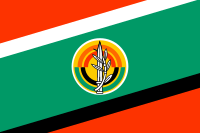 Flag of the Israeli Ground Forces | |
| Founded | 1948 |
| Service branches | |
| Headquarters | GOC Army Headquarters (Bar-Lev Camp) |
| Website | Official website |
| Leadership | |
| Prime Minister | |
| Defense Minister | |
| Chief of the General Staff | |
| General Officer Commanding | Major General Yoel Strick[1] |
| Personnel | |
| Active personnel | 133,000 |
| Reserve personnel | 380,000 |
| Industry | |
| Domestic suppliers | |
| Foreign suppliers | |
| Related articles | |
| History | 1948 Arab–Israeli War (1948–1949) Reprisal operations (1951–1956) Suez Crisis (1956) Six-Day War (1967) War of Attrition (1967–1970) Yom Kippur War (1973) 1978 South Lebanon conflict (1978) 1982 Lebanon War (1982–1985) South Lebanon conflict (1985–2000) First Intifada (1987–1993) Second Intifada (2000–2005) 2006 Lebanon War (2006) Operation Cast Lead (2008–2009) Operation Pillar of Defense (2012) Operation Protective Edge (2014) Others |
| Ranks | Israel Defense Forces ranks |
The Israeli Ground Forces (Template:Lang-he) are the ground forces of the Israel Defense Forces (IDF). The commander is the General Officer Commanding with the rank of Major General, the Mazi, subordinate to the Chief of General Staff.
An order from Defense Minister David Ben-Gurion on 26 May 1948 officially set up the Israel Defense Forces as a conscript army formed out of the paramilitary group Haganah, incorporating the militant groups Irgun and Lehi. The Ground Forces have served in all the country's major military operations—including the 1948 Arab–Israeli War, 1956 Suez Crisis, 1967 Six-Day War, 1973 Yom Kippur War, 1976 Operation Entebbe, 1982 Lebanon War, 1987–1993 First Intifada, 2000–2005 Second Intifada, 2006 Lebanon War, and the Gaza War (2008–09). While originally the IDF operated on three fronts—against Lebanon and Syria in the north, Jordan and Iraq in the east, and Egypt in the south—after the 1979 Egyptian–Israeli Peace Treaty, it has concentrated in southern Lebanon and the Palestinian Territories, including the First and the Second Intifada.
The Ground Forces uses several technologies developed in Israel such as the Merkava main battle tank, Achzarit armoured personnel carrier, the Iron Dome missile defense system, Trophy active protection system for vehicles, and the Galil and Tavor assault rifles. The Uzi submachine gun was invented in Israel and used by the Ground Forces until December 2003, ending a service that began in 1954. Since 1967, the IDF has had close military relations with the United States,[2] including development cooperation, such as on the THEL laser defense system, and the Arrow missile defense system.
History
This section needs additional citations for verification. (January 2013) |
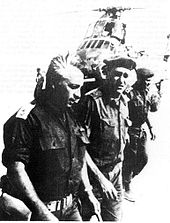
The IDF traces its roots to Jewish paramilitary organizations in the New Yishuv, starting with the Second Aliyah (1904 to 1914).[3] The first such organization was Bar-Giora, founded in September 1907. Bar-Giora was transformed into Hashomer in April 1909, which operated until the British Mandate of Palestine came into being in 1920. Hashomer was an elitist organization with narrow scope, and was mainly created to protect against criminal gangs seeking to steal property. The Zion Mule Corps and the Jewish Legion, both part of the British Army of World War I, would further bolster the Yishuv with military experience and manpower, forming the basis for later paramilitary forces. After the 1920 Palestine riots against Jews in April 1920, the Yishuv leadership realised the need for a nationwide underground defense organization, and the Haganah was founded in June of the same year.[4] The Haganah became a full-scale defense force after the 1936–1939 Arab revolt in Palestine with an organized structure, consisting of three main units—the Field Corps, Guard Corps, and the Palmach. During World War II, the Yishuv participated in the British war effort, culminating in the formation of the Jewish Brigade. These would eventually form the backbone of the Israel Defense Forces, and provide it with its initial manpower and doctrine.
Following Israel's Declaration of Independence, Prime Minister and Defense Minister David Ben-Gurion issued an order for the formation of the Israel Defense Forces on 26 May 1948. Although Ben-Gurion had no legal authority to issue such an order, the order was made legal by the cabinet on 31 May. The same order called for the disbandment of all other Jewish armed forces.[5] The two other Jewish underground organizations, Irgun and Lehi, agreed to join the IDF if they would be able to form independent units and agreed not to make independent arms purchases. This was the background for the Altalena Affair, a confrontation surrounding weapons purchased by the Irgun resulting in a standoff between Irgun members and the newly created IDF. The affair came to an end when Altalena, the ship carrying the arms, was shelled by the IDF. Following the affair, all independent Irgun and Lehi units were either disbanded or merged into the IDF. The Palmach, a leading component of the Haganah, also joined the IDF with provisions, and Ben Gurion responded by disbanding its staff in 1949, after which many senior Palmach officers retired, notably its first commander, Yitzhak Sadeh.
The new army organized itself when the 1947–48 Civil War in Mandatory Palestine escalated into the 1948 Arab–Israeli War, which saw neighbouring Arab states attack. Twelve infantry and armored brigades formed: Golani, Carmeli, Alexandroni, Kiryati, Givati, Etzioni, the 7th, and 8th armored brigades, Oded, Harel, Yiftach, and Negev.[6] After the war, some of the brigades were converted to reserve units, and others were disbanded. Directorates and corps were created from corps and services in the Haganah, and this basic structure in the IDF still exists today.
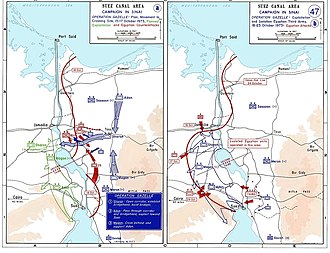
Immediately after the 1948 war, the Israel-Palestinian conflict shifted to a low intensity conflict between the IDF and Palestinian fedayeen. In the 1956 Suez Crisis, the IDF's first serious test of strength after 1949, the new army captured the Sinai Peninsula from Egypt, which was later returned. In the 1967 Six-Day War, Israel conquered the Sinai Peninsula, Gaza Strip, West Bank (including East Jerusalem) and Golan Heights from the surrounding Arab states, changing the balance of power in the region as well as the role of the IDF. In the following years leading up to the Yom Kippur War, the IDF fought in the War of Attrition against Egypt in the Sinai and a border war against the Palestine Liberation Organization (PLO) in Jordan, culminating in the Battle of Karameh.
The surprise of the Yom Kippur War and its aftermath completely changed the IDF's procedures and approach to warfare. Organizational changes were made[by whom?] and more time was dedicated to training for conventional warfare. However, in the following years the army's role slowly shifted again to low-intensity conflict, urban warfare and counter-terrorism. An example of the latter was the successful 1976 Operation Entebbe commando raid to free hijacked airline passengers being held captive in Uganda. During this era, the IDF also mounted a successful bombing mission in Iraq to destroy its nuclear reactor. It was involved in the Lebanese Civil War, initiating Operation Litani and later the 1982 Lebanon War, where the IDF ousted Palestinian guerilla organizations from Lebanon. Palestinian militancy has been the main focus of the IDF ever since, especially during the First and Second Intifadas, Operation Defensive Shield, the Gaza War, Operation Pillar of Defense, and Operation Protective Edge, causing the IDF to change many of its values and publish the IDF Spirit. The Lebanese Shia organization Hezbollah has also been a growing threat,[7] against which the IDF fought an asymmetric conflict between 1982 and 2000, as well as a full-scale war in 2006.
Organization

The IDF is an integrated military force, without a separate ground arm from 1948 to 1998, when the Ground Forces were formally brought under a single command now known as GOC Army Headquarters (Template:Lang-he, Mifkedet Zro'a HaYabasha, abbreviated Mazi). However, the Ground Forces are not yet a formal arm of the IDF, in the same way that the Israeli Air Force and Israeli Navy are.
Structure
The Ground Forces include the following Corps:
|
|
|
Units
| Ground Forces | ||
|---|---|---|
| Hebrew | English | Commander |
| חֻלְיָה Hulya |
Fire Team | Mashak Hulya ("Fire Team Leader") Corporal or Sergeant |
| כִּתָּה Kita |
Squad / Section | Mashak Kita ("Squad / Section Leader") Staff Sergeant |
| מַחְלָקָה Mahlaka |
Platoon | Mefaked Mahlaka ("Platoon Commander") Lieutenant |
| פְּלֻגָּה Pluga |
Company | Mefaked Pluga ("Company Commander") Captain |
| סוֹלְלָה Solela |
Artillery Battery | Captain or Major |
| סַיֶּרֶת Sayeret |
Reconnaissance | Captain or Major |
| גְּדוּד Gdud |
Battalion | Lieutenant-Colonel |
| חֲטִיבָה Hativa |
Brigade | Colonel |
| אֻגְדָּה Ugda |
Division | (1948–1967) Major-General (1968–Present) Brigadier-General |
| גַּיִס Gayis |
Army | Major-General |
Ranks, uniforms and insignia
Ranks

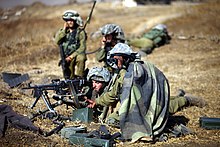

Unlike most militaries, the IDF uses the same rank names in all corps, including the air force and navy. For ground forces' officers, rank insignia are brass on a red background. Officer insignia are worn on epaulets on top of both shoulders. Insignia distinctive to each corps are worn on the cap.



Enlisted grades wear rank insignia on the sleeve, halfway between the shoulder and the elbow. For the ground forces, the insignia are white with blue interwoven threads backed with the appropriate corps color.
From the formation of the IDF until the late 1980s, sergeant major was a particularly important warrant officer rank, in line with usage in other armies. However, in the 1980s and 1990s the proliferating ranks of sergeant major became devalued, and now all professional non-commissioned officer ranks are a variation on sergeant major (rav samal) with the exception of rav nagad.
All translations here are the official translations of the IDF's website.[8]
Conscripts (Hogrim) (Conscript ranks may be gained purely on time served)
- Private (Turai)
- Corporal (Rav Turai)
- Sergeant (Samal)
- First Sergeant (Samal Rishon)
Warrant Officers (Nagadim)
- Sergeant First Class (Rav Samal)
- Master Sergeant (Rav Samal Rishon)
- Sergeant Major (Rav Samal Mitkadem)
- Warrant Officer (Rav Samal Bakhir)
- Master Warrant Officer (Rav Nagad Mishneh)
- Chief Warrant Officer (Rav Nagad)
Academic officers (Ktzinim Akadema'im)
- Professional Academic Officer (Katzin Miktzo'i Akadema'i)
- Senior Academic Officer (Katzin Akadema'i Bakhir)
Officers (Ktzinim)
- Second Lieutenant (Segen Mishneh) [1951–Present]
- Lieutenant (Segen)
- Captain (Seren)
- Major (Rav Seren)
- Lieutenant Colonel (Sgan Aluf)
- Colonel (Aluf Mishneh) [1950–Present]
- Brigadier General (Tat Aluf) [1968–Present]
- Major General (Aluf) [1948–Present]
- Lieutenant General (Rav Aluf)
Uniforms


The Israel Defense Forces has several types of uniforms:
- Service dress (מדי אלף Madei Alef – Uniform "A") – the everyday uniform, worn by everybody.
- Field dress ( מדי ב Madei Bet – Uniform "B") – worn into combat, training, work on base.
The first two resemble each other but the Madei Alef is made of higher quality materials in a golden-olive while the madei bet is in olive drab.[9][10] The dress uniforms may also exhibit a surface shine[10][11]
- Officers / Ceremonial dress (מדי שרד madei srad) – worn by officers, or during special events/ceremonies.
- Dress uniform and mess dress – worn only abroad. There are several dress uniforms depending on the season and the branch.
The service uniform for all ground forces personnel is olive green. The uniforms consist of a two-pocket shirt, combat trousers, sweater, jacket or blouse, and shoes or boots. The green fatigues are the same for winter and summer and heavy winter gear is issued as needed. Women's dress parallels the men's but may substitute a skirt for the trousers.


Headgear included a service cap for dress and semi-dress and a field cap or "Kova raful" bush hat worn with fatigues. IDF personnel generally wear berets in lieu of the service cap and there are many beret colors issued to IDF personnel. Paratroopers are issued a maroon beret, Golani brown, Givati purple, Nahal lime green, Kfir camouflage, Combat Engineers gray. Other beret colors are: black for armored corps, turquoise for artillery personnel. For all other ground personnel, except combat units, the beret for men was green and for women, black.
In combat uniforms the Orlite helmet has replaced the British Brodie helmet Mark II/Mark III, RAC Mk II modified helmet with chin web jump harness (used by paratroopers and similar to the HSAT Mk II/Mk III paratrooper helmets),[12] US M1 helmet,[13] and French Modèle 1951 helmet – previously worn by Israeli infantry and airborne troops from the late 1940s to the mid-1970s and early 1980s.[14]
Some corps or units have small variations in their uniforms – for instance, military policemen wear a white belt and police hat, and paratroopers are issued a four pocket tunic (yarkit/yerkit) worn untucked with a pistol belt cinched tight around the waist over the shirt.[15]
Most IDF soldiers are issued black leather combat boots, certain units issue reddish-brown leather boots for historical reasons — the paratroopers,[15] combat medics, Nahal and Kfir Brigades, as well as some Special Forces units (Sayeret Matkal, Oketz, Duvdevan, Maglan, and the Counter-Terror School). Women were also formerly issued sandals, but this practice has ceased.
Insignia
IDF soldiers have three types of insignia (other than rank insignia) which identify their corps, specific unit, and position.
A pin attached to the beret identifies a soldier's corps. Soldiers serving in staffs above corps level are often identified by the General Corps pin, despite not officially belonging to it, or the pin of a related corps. New recruits undergoing basic training (tironut) do not have a pin. Beret colors are also often indicative of the soldier's corps, although most non-combat corps do not have their own beret, and sometimes wear the color of the corps to which the post they're stationed in belongs. Individual units are identified by a shoulder tag attached to the left shoulder strap. Most units in the IDF have their own tags, although those that do not, generally use tags identical to their command's tag (corps, directorate, or regional command).
While one cannot always identify the position/job of a soldier, two optional factors help make this identification: an aiguillette attached to the left shoulder strap and shirt pocket, and a pin indicating the soldier's work type (usually given by a professional course). Other pins may indicate the corps or additional courses taken. Finally, an optional battle pin indicates a war that a soldier has fought in.
Service
The military service is held in three different tracks:
- Regular service (שירות חובה): mandatory military service which is held according to the Israeli security service law.
- Permanent service (שירות קבע): military service which is held as part of a contractual agreement between the IDF and the permanent position-holder.
- Reserve service (שירות מילואים): a military service in which citizens are called for active duty of at most a month every year (in accordance with the Reserve Service Law), for training and ongoing military activities and especially for the purpose of increasing the military forces in case of a war.
Sometimes the IDF would also hold pre-military courses (קורס קדם צבאי or קד"צ) for soon-to-be regular service soldiers.
Women
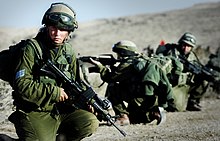

Israel is one of only a few nations that conscript women or deploy them in combat roles, although in practice, women can avoid conscription through a religious exemption and over a third of Israeli women do so.[17] As of 2010, 88% of all roles in the IDF are open to female candidates, and women could be found in 69% of all IDF positions.[18]
According to the IDF, 535 female Israeli soldiers were killed in combat operations in the period 1962–2016,[19] and dozens before then. The IDF says that fewer than 4 percent of women are in combat positions. Rather, they are concentrated in "combat-support" positions which command a lower compensation and status than combat positions.[20]
Mission
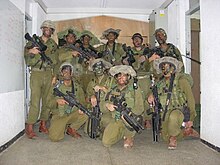
The IDF's mission is to "defend the existence, territorial integrity and sovereignty of the state of Israel. To protect the inhabitants of Israel and to combat all forms of terrorism which threaten the daily life."[21]

The Israeli military's primary principles derive from Israel's need to combat numerically superior opponents. One such principle, is the concept that Israel cannot afford to lose a single war. The IDF believes that this is possible if it can rapidly mobilize troops to insure that they engage the enemy in enemy territory.[22] In the 21st Century, various nonconventional threats including terrorist organizations, subterranean infrastructure operated by Hamas, etc. have forced the IDF to modify its official defense doctrine.[23]
Field rations
Field rations, called manot krav, usually consist of canned tuna, sardines, beans, stuffed vine leaves, maize and fruit cocktail and bars of halva. Packets of fruit flavored drink powder are also provided along with condiments like ketchup, mustard, chocolate spread and jam. Around 2010, the IDF announced that certain freeze dried MREs served in water activated disposable heaters like goulash, turkey schwarma and meatballs would be introduced as field rations.[24]
One staple of these rations was loof, a type of Kosher spam made from chicken or beef that was phased out around 2008.[25] Food historian Gil Marks has written that: "Many Israeli soldiers insist that Loof uses all the parts of the cow that the hot dog manufacturers will not accept, but no one outside of the manufacturer and the kosher supervisors actually know what is inside."[26]
Weapons and equipment

The Ground Forces possess various domestic and foreign weapons and computer systems. Some equipment is from the United States (modified for IDF use) such as the M4A1 and M16 assault rifles, the M24 SWS 7.62 mm bolt action sniper rifle, the SR-25 7.62 mm semi-automatic sniper rifle, and the AH-1 Cobra and AH-64D Apache attack helicopters.
Israel has a domestic arms industry, which has developed weapons and vehicles such as the Merkava battle tank series, and various small arms such as the Galil and Tavor assault rifles, and the Uzi submachine gun.

Israel has also installed a variant of the Samson RCWS, a remote controlled weapons platform, which can include machine guns, grenade launchers, and anti-tank missiles on a remotely operated turret, in pillboxes along the Israeli Gaza Strip barrier to prevent Palestinian militants from entering its territory.[27][28] Israel has developed observation balloons equipped with sophisticated cameras and surveillance systems used to thwart terror attacks from Gaza.[29] The Ground Forces also possess advanced combat engineering equipment including the IDF Caterpillar D9 armored bulldozer, IDF Puma combat engineering vehicle, Tzefa Shiryon and CARPET minefield breaching rockets, and a variety of robots and explosive devices.
Future

The IDF is planning a number of technological upgrades and structural reforms for the future. Training has been increased with greater cooperation between ground, air, and naval units.[30]
The Ground Forces are phasing out the M-16 rifle in favor of the IWI Tavor variants, most recently the IWI Tavor X95 flat-top ("Micro-Tavor Dor Gimel").[31] In addition, the outdated M113 armored personnel carriers are being replaced by the new Namer APCs, with 200 ordered in 2014, as well as obtaining the Eitan AFV, and is upgrading its IDF Achzarit APCs.[32][33]
The backbone of the Artillery Corps, the M109 howitzer, will be phased out in favor of a still-undecided replacement, with the ATMOS 2000 and Artillery Gun Module under primary consideration.[34]

The IDF is also planning a future tank to replace the Merkava, which will be able to fire lasers and electromagnetic pulses, run on a hybrid engine, with a crew as small as two, will be faster, and will be better-protected, with emphasis on protection systems such as the Trophy over armor.[35][36]
The Combat Engineering Corps assimilated new technologies, mainly in tunnel detection and unmanned ground vehicles and military robots, such as remote-controlled IDF Caterpillar D9T "Panda" armored bulldozers, Sahar engineering scout robot and improved Remotec ANDROS robots.
See also
- Israeli Air Force
- Israeli Navy
- Israeli Intelligence Community
- Israel Border Police
- Israel Military Industries
Related subjects
References and footnotes
- ^ "General Staff". Israel Defense Forces.
- ^ Mahler, Gregory S. (1990). Israel After Begin. SUNY Press. p. 45. ISBN 978-0-7914-0367-9.
- ^ Speedy (12 September 2011). "The Speedy Media: IDF's History". Thespeedymedia.blogspot.com. Retrieved 3 August 2014.
- ^ "HAGANAH". encyclopedia.com. The Gale Group, Inc. Retrieved 23 January 2019.
The Haganah ("defense") was founded in June 1920...
- ^ Ostfeld, Zehava (1994). Shoshana Shiftel (ed.). An Army is Born (in Hebrew). Vol. 1. Israel Ministry of Defense. pp. 104–106. ISBN 978-965-05-0695-7.
- ^ Pa'il, Meir (1982). "The Infantry Brigades". In Yehuda Schiff (ed.). IDF in Its Corps: Army and Security Encyclopedia (in Hebrew). Vol. 11. Revivim Publishing. p. 15.
- ^ "Hezbollah hiding 100,000 missiles that can hit north, army says". The Times of Israel. Retrieved 8 March 2016.
- ^ "IDF Ranks". IDF. Archived from the original on 30 August 2009. Retrieved 10 June 2010.
- ^ Israeli Defence Forces since 1973, Osprey – Elite Series #8, Sam Katz 1986, ISNC 0-85045-887-8
- ^ a b "Guide to Israeli Militaria, Insignia, Badges, Uniforms & Unit Formations at Historama.com | The Online History Shop". Historama.com. 2 August 1945. Retrieved 3 August 2014.
- ^ "GarinMahal – Your first day in the IDF". Retrieved 8 March 2016.
- ^ Katz & Volstad, Israeli Elite Units since 1948 (1988), pp. 53-54; 56.
- ^ Katz & Volstad, Israeli Elite Units since 1948 (1988), pp. 54-55; 57-59.
- ^ Katz & Volstad, Israeli Elite Units since 1948 (1988), p. 60.
- ^ a b https://www.idf.il/en/minisites/paratroopers-brigade/
- ^ Brothers and others in arms: the making of love and war in Israeli combat units, Routledge, 2003, Danny Kaplan
- ^ Abuse of IDF Exemptions Questioned The Jewish Daily Forward, 16 December 2009
- ^ Statistics: Women's Service in the IDF for 2010 Archived 13 May 2015 at the Wayback Machine IDF, 25 August 2010
- ^ "Israeli woman who broke barriers downed by Hezbollah rocket as 2006 combat volunteer – Israel News". Haaretz.
- ^ Gaza: It's a Man's War The Atlantic, 7 August 2014
- ^ "IDF desk – Doctrine, Mission". Dover.idf.il. Archived from the original on 2 November 2010. Retrieved 1 June 2010.
- ^ "Israel Defense Forces". britannica.com. Encyclopedia Britannica. Retrieved 23 January 2019.
- ^ "Israel Defense Forces Strategy Document". belfercenter.org. Harvard Kennedy School of Government. Retrieved 23 January 2019.
- ^ Steinberg, Jessica. "The rationale behind the rations". The Times of Israel. Retrieved 20 September 2018.
- ^ "6 things you never knew about Spam" (Text.Article). The Daily Meal. 28 September 2016. Retrieved 20 September 2018.
- ^ "Kosher Spam: a Breef history". Jewish Telegraphic Agency. 20 November 2011. Retrieved 20 September 2018.
- ^ "Weaponized Sentry-Tech Towers Protecting Hot Borders". Aviationweek.com. 4 December 2008. Retrieved 1 October 2010.
- ^ Palestine Chronicle (13 July 2010). "Israel's New 'Video Game' Executions". Eurasia Review. Retrieved 8 August 2010.[permanent dead link]
- ^ "IDF observation balloon crashes near Gaza", Ynet News 5 May 2012
- ^ "Analysis The Israeli Army's New Target: Itself". Haaretz. Retrieved 8 March 2016.
- ^ Jerusalem Post: IDF phasing out M-16 in favor of Israeli-made Tavor (19 December 2012)
- ^ "Israel to upgrade more Achzarit APCs". Retrieved 8 March 2016.
- ^ Yehoshua, Yossi (22 September 2014). "Ya'alon approves addition of 200 advanced APCs for the IDF". ynet. Retrieved 8 March 2016.
- ^ Administrator. "Israel Army wants to replace old 155mm howitzer M109 with Soltam or AGM artillery system 3010134 – October 2013 defense industry military news UK – Military army defense industry news year 2013". Retrieved 8 March 2016.
- ^ Jerusalem Post: The IDF's future tank: Electromagnetic cannon
- ^ "IDF to discharge 100,000 reservists, slash officer corps". The Times of Israel. Retrieved 8 March 2016.
Further reading
- Marcus, Raphael D. Israel's Long War with Hezbollah: Military Innovation and Adaptation under Fire (Georgetown UP, 2018) online review
- Rosenthal, Donna (2003). The Israelis. Free Press. ISBN 978-0-7432-7035-9.
- Ostfeld, Zehava (1994). Shiftel, Shoshana (ed.). An Army is Born (in Hebrew). Israel Ministry of Defense. ISBN 978-965-05-0695-7.
- Gelber, Yoav (1986). Nucleus for a Standing Army (in Hebrew). Yad Ben Tzvi.
- Yehuda Shif, ed. (1982). IDF in Its Corps: Army and Security Encyclopedia (18 volumes) (in Hebrew). Revivim Publishing.
- Ron Tira, ed. (2009). The Nature of War: Conflicting Paradigms and Israeli Military Effectiveness. Sussex Academic Press. ISBN 978-1-84519-378-2.
- Roislien, Hanne Eggen (2013). "Religion and Military Conscription: The Case of the Israeli Defense Forces (IDF)," Armed Forces & Society 39, No. 3, pp. 213–232.
- Country Briefing: Israel, Jane's Defence Weekly, 19 June 1996
External links
